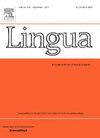On Korean progressive/perfect constructions
IF 1.3
3区 文学
0 LANGUAGE & LINGUISTICS
引用次数: 0
Abstract
It is well-known that the −ko iss- form in Korean is ambiguous, being interpreted as either a progressive reading or a resultant state reading. The primary claim of this article is that −ko iss- is, in fact, six-way ambiguous. This ambiguity arises from the interplay of three factors: the ambiguity of −ko, the ambiguity of iss-, and the optional presence of the light verb v*. The morpheme −ko is ambiguous between ‘simultaneous’ (+Simul) and ‘non-simultaneous’ (−Simul) readings. When used as an aspect marker, −ko[+Simul] denotes the in-progress state of an event, while −ko[−Simul] indicates either a resultant state or a continuative state of the event or state. Meanwhile, iss- can be interpreted either as a raising predicate or as a control predicate. Furthermore, the −ko iss- form can optionally co-occur with the light verb v*. Given these ambiguities, there are theoretically eight possible −ko iss- constructions. However, this article shows that only six of these are attested, as some combinations result in pragmatic anomaly. In accounting for the −ko iss- form, this article demonstrates that Korean progressive and perfect constructions share a striking similarity with their English counterparts, as both rely on the same underlying mechanism.
关于韩语进行式/完成式
众所周知,韩国语中的“- ko -”形式是模棱两可的,被解释为一种渐进阅读或一种结果状态阅读。这篇文章的主要观点是,“- ko -”实际上是有六种歧义的。这种歧义源于三个因素的相互作用:- ko的歧义,iss-的歧义,以及可选的轻动词v*的存在。语素- ko在“同时”(+Simul)和“非同时”(- Simul)阅读之间是模糊的。当用作方面标记时,−ko[+Simul]表示事件正在进行的状态,而−ko[−Simul]表示事件或状态的结果状态或连续状态。同时,iss-既可以解释为提升谓词,也可以解释为控制谓词。此外,- ko -形式可以选择性地与轻动词v*同时出现。考虑到这些歧义,理论上有八种可能的- ko - iss结构。然而,本文只证明了其中的六种,因为一些组合会导致语用异常。在考虑- ko -形式时,本文表明韩语的进行式和完成式与英语的进行式和完成式有着惊人的相似之处,因为它们都依赖于相同的潜在机制。
本文章由计算机程序翻译,如有差异,请以英文原文为准。
求助全文
约1分钟内获得全文
求助全文
来源期刊

Lingua
Multiple-
CiteScore
2.50
自引率
9.10%
发文量
93
审稿时长
24 weeks
期刊介绍:
Lingua publishes papers of any length, if justified, as well as review articles surveying developments in the various fields of linguistics, and occasional discussions. A considerable number of pages in each issue are devoted to critical book reviews. Lingua also publishes Lingua Franca articles consisting of provocative exchanges expressing strong opinions on central topics in linguistics; The Decade In articles which are educational articles offering the nonspecialist linguist an overview of a given area of study; and Taking up the Gauntlet special issues composed of a set number of papers examining one set of data and exploring whose theory offers the most insight with a minimal set of assumptions and a maximum of arguments.
 求助内容:
求助内容: 应助结果提醒方式:
应助结果提醒方式:


